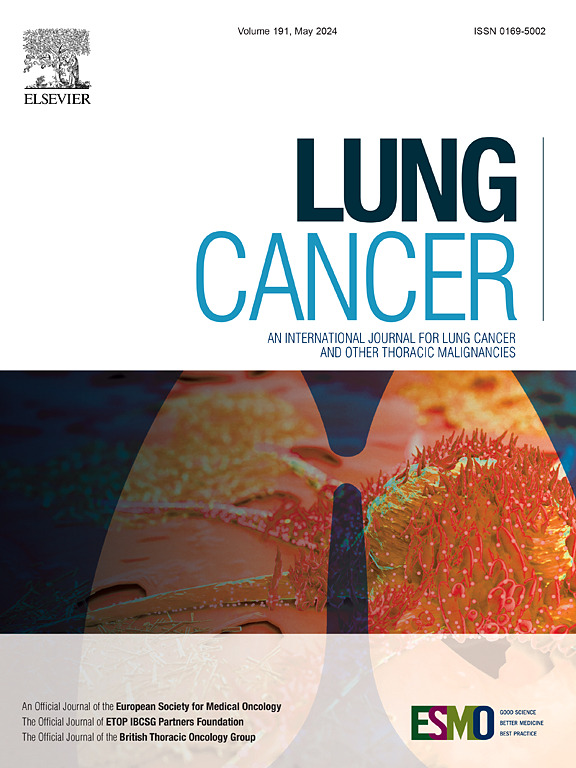The diagnostic value of comprehensive next-generation sequencing for genetic mutations in suspected lung cancer cases with negative pathological cytology
IF 4.5
2区 医学
Q1 ONCOLOGY
引用次数: 0
Abstract
Introduction
In recent clinical practice, driver gene mutations have been tested using multiplex PCR or next-generation sequencing (NGS), which help determine treatment strategies for non-small cell lung cancer (NSCLC). We developed a new analysis system, the Mutation Investigator using Next-era Sequencer (MINtS), using NGS, which allows for the detection of gene mutations even in cytology specimens with low tumor cell content. Due to its high sensitivity, MINtS has the potential to detect gene mutations even in specimens that are pathologically negative for cancer. In the present study, we examined the utility of MINtS-based mutation detection in cytology-negative specimens.
Methods
We retrospectively analyzed the data of patients who were enrolled in the NEJ021A study, which was a prospective observational study investigating the performance of MINtS. Although NEJ021A was a multicenter study, we included only patients enrolled at Niigata University Medical and Dental Hospital.
Results
Cytology specimens from 486 patients with suspected lung cancer were analyzed using MINtS. Among the cytology-positive cases, driver gene mutations were detected in 37.3 % (93/249) of patients, whereas in cytology-negative cases, driver gene mutations were detected in 20.2 % (47/233) of patients using MINtS. Of the 47 patients whose specimens were cytology-negative and MINtS-positive, 42 were histologically or clinically diagnosed with NSCLC and received treatment.
Conclusions
Even in patients without a pathological diagnosis of lung cancer, MINtS can identify driver gene mutations, which can be useful for guiding subsequent treatment decisions.
在病理细胞学阴性的疑似肺癌病例中,下一代综合测序对基因突变的诊断价值。
导言:在最近的临床实践中,使用多重 PCR 或下一代测序(NGS)检测驱动基因突变有助于确定非小细胞肺癌(NSCLC)的治疗策略。我们利用 NGS 开发了一种新的分析系统--使用下一代测序仪的突变调查器(MINtS),即使在肿瘤细胞含量较低的细胞学标本中也能检测基因突变。MINtS 的灵敏度很高,即使在病理检测为阴性的标本中也能检测到基因突变。在本研究中,我们考察了基于 MINtS 的基因突变检测在细胞学阴性标本中的应用:我们回顾性地分析了参加 NEJ021A 研究的患者数据,该研究是一项前瞻性观察研究,旨在调查 MINtS 的性能。虽然 NEJ021A 是一项多中心研究,但我们只纳入了新潟大学医科齿科医院的患者:结果:我们使用 MINtS 分析了 486 例疑似肺癌患者的细胞学标本。在细胞学阳性病例中,37.3%(93/249)的患者检测到驱动基因突变,而在细胞学阴性病例中,使用 MINtS 检测到驱动基因突变的患者占 20.2%(47/233)。在标本为细胞学阴性和MINtS阳性的47例患者中,42例经组织学或临床诊断为NSCLC并接受了治疗:结论:即使是未经病理诊断的肺癌患者,MINtS 也能发现驱动基因突变,这有助于指导后续的治疗决策。
本文章由计算机程序翻译,如有差异,请以英文原文为准。
求助全文
约1分钟内获得全文
求助全文
来源期刊

Lung Cancer
医学-呼吸系统
CiteScore
9.40
自引率
3.80%
发文量
407
审稿时长
25 days
期刊介绍:
Lung Cancer is an international publication covering the clinical, translational and basic science of malignancies of the lung and chest region.Original research articles, early reports, review articles, editorials and correspondence covering the prevention, epidemiology and etiology, basic biology, pathology, clinical assessment, surgery, chemotherapy, radiotherapy, combined treatment modalities, other treatment modalities and outcomes of lung cancer are welcome.
 求助内容:
求助内容: 应助结果提醒方式:
应助结果提醒方式:


